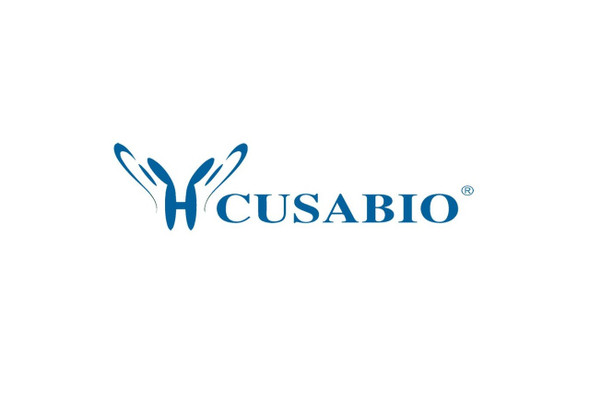Cusabio Active Proteins
Recombinant Human EGFR (Active)
- SKU:
- CSB-MP007479HU
- Availability:
- 3 to 7 Working Days
Description
Recombinant Human Epidermal growth factor receptor (EGFR) ,partial (Active) | CSB-MP007479HU | Cusabio
The recombinant human epidermal growth factor receptor (EGFR) is expressed from mammalian cells and fused with a 10xHis-tag at the N-terminus and a Myc-tag at the C-terminus. It contains amino acid residues 25-645 of the human EGFR protein. Its protein length covers the extracellular domain of the EGFR protein. The purity of this EGFR protein is greater than 90% determined by SDS-PAGE. The endotoxin content of recombinant EGFR protein is less than 1.0 EU/ug measured by the LAL method. Importantly, it has been validated to be active. In the functional ELISA, this EGFR protein can bind to the anti-EGFR antibody and Cetuximab, respectively. The EC50 is 2.867-3.571 ng/ml and 0.6919-1.047 ng/ml, respectively. In the LSPR assay, the human EGF captured on the COOH chip can bind to this EGFR protein with an affinity constant of 11.9 nM. And it is in stock now.
EGFR is a receptor tyrosine kinase that phosphorylates numerous intracellular substrates that activate pathways resulting in cell growth, DNA synthesis, and expression of oncogenes such as Fos and Jun. It regulates epithelial tissue development and homeostasis under physiological conditions but drives tumorigenesis in pathological settings, especially in lung and breast cancer. EGFR has been identified to be one of the most frequently changed oncogenes in solid tumors.
Protein Description: Partial
Alternative Name (s) : Proto-oncogene c-ErbB-1 (Receptor tyrosine-protein kinase erbB-1) (ERBB) (ERBB1) (HER1)
Gene Names: EGFR
Research Areas: Cancer
Species: Homo sapiens (Human)
Source: Mammalian cell
Tag Info: N-terminal 10xHis-tagged and C-terminal Myc-tagged
Expression Region: 25-645aa
Sequence Info: LEEKKVCQGTSNKLTQLGTFEDHFLSLQRMFNNCEVVLGNLEITYVQRNYDLSFLKTIQEVAGYVLIALNTVERIPLENLQIIRGNMYYENSYALAVLSNYDANKTGLKELPMRNLQEILHGAVRFSNNPALCNVESIQWRDIVSSDFLSNMSMDFQNHLGSCQKCDPSCPNGSCWGAGEENCQKLTKIICAQQCSGRCRGKSPSDCCHNQCAAGCTGPRESDCLVCRKFRDEATCKDTCPPLMLYNPTTYQMDVNPEGKYSFGATCVKKCPRNYVVTDHGSCVRACGADSYEMEEDGVRKCKKCEGPCRKVCNGIGIGEFKDSLSINATNIKHFKNCTSISGDLHILPVAFRGDSFTHTPPLDPQELDILKTVKEITGFLLIQAWPENRTDLHAFENLEIIRGRTKQHGQFSLAVVSLNITSLGLRSLKEISDGDVIISGNKNLCYANTINWKKLFGTSGQKTKIISNRGENSCKATGQVCHALCSPEGCWGPEPRDCVSCRNVSRGRECVDKCNLLEGEPREFVENSECIQCHPECLPQAMNITCTGRGPDNCIQCAHYIDGPHCVKTCPAGVMGENNTLVWKYADAGHVCHLCHPNCTYGCTGPGLEGCPTNGPKIPS
Biological Activity: Measured by its binding ability in a functional ELISA. Immobilized EGFR at 1 μg/ml can bind Anti-EGFR recombinant antibody, the EC50 of human EGFR protein is 2.867-3.571 ng/ml.
MW: 73.6 kDa
Purity: Greater than 90% as determined by SDS-PAGE.
Endotoxin: Less than 1.0 EU/ug as determined by LAL method.
Relevance: Receptor tyrosine kinase binding ligands of the EGF family and activating several signaling cascades to convert extracellular cues into appropriate cellular responses. Known ligands include EGF, TGFA/TGF-alpha, AREG, epigen/EPGN, BTC/betacellulin, epiregulin/EREG and HBEGF/heparin-binding EGF. Ligand binding triggers receptor homo- and/or heterodimerization and autophosphorylation on key cytoplasmic residues. The phosphorylated receptor recruits adapter proteins like GRB2 which in turn activates complex downstream signaling cascades. Activates at least 4 major downstream signaling cascades including the RAS-RAF-MEK-ERK, PI3 kinase-AKT, PLCgamma-PKC and STATs modules. May also activate the NF-kappa-B signaling cascade. Also directly phosphorylates other proteins like RGS16, activating its GTPase activity and probably coupling the EGF receptor signaling to the G protein-coupled receptor signaling. Also phosphorylates MUC1 and increases its interaction with SRC and CTNNB1/beta-catenin. Plays a role in enhancing learning and memory performance.Isoform 2 may act as an antagonist of EGF action. Acts as a receptor for hepatitis C virus in hepatocytes and facilitates its cell entry. Mediates HCV entry by promoting the formation of the CD81-CLDN1 receptor complexes that are essential for HCV entry and by enhancing membrane fusion of cells expressing HCV envelope glycoproteins.
PubMed ID:
Notes: Repeated freezing and thawing is not recommended. Store working aliquots at 4℃ for up to one week.
Function: Receptor tyrosine kinase binding ligands of the EGF family and activating several signaling cascades to convert extracellular cues into appropriate cellular responses. Known ligands include EGF, TGFA/TGF-alpha, amphiregulin, epigen/EPGN, BTC/betacellulin, epiregulin/EREG and HBEGF/heparin-binding EGF. Ligand binding triggers receptor homo- and/or heterodimerization and autophosphorylation on key cytoplasmic residues. The phosphorylated receptor recruits adapter proteins like GRB2 which in turn activates complex downstream signaling cascades. Activates at least 4 major downstream signaling cascades including the RAS-RAF-MEK-ERK, PI3 kinase-AKT, PLCgamma-PKC and STATs modules. May also activate the NF-kappa-B signaling cascade. Also directly phosphorylates other proteins like RGS16, activating its GTPase activity and probably coupling the EGF receptor signaling to the G protein-coupled receptor signaling. Also phosphorylates MUC1 and increases its interaction with SRC and CTNNB1/beta-catenin. Plays a role in enhancing learning and memory performance (By similarity) .
Involvement in disease: Lung cancer (LNCR) ; Inflammatory skin and bowel disease, neonatal, 2 (NISBD2)
Subcellular Location: Cell membrane, Single-pass type I membrane protein, Endoplasmic reticulum membrane, Single-pass type I membrane protein, Golgi apparatus membrane, Single-pass type I membrane protein, Nucleus membrane, Single-pass type I membrane protein, Endosome, Endosome membrane, Nucleus
Protein Families: Protein kinase superfamily, Tyr protein kinase family, EGF receptor subfamily
Tissue Specificity: Ubiquitously expressed. Isoform 2 is also expressed in ovarian cancers.
Paythway: Calciumsignalingpathway
Form: Lyophilized powder
Buffer: Lyophilized from a 0.2 μm filtered 20 mM Tris-HCl, 0.5 M NaCl, 6% Trehalose, pH 8.0
Reconstitution: We recommend that this vial be briefly centrifuged prior to opening to bring the contents to the bottom. Please reconstitute protein in deionized sterile water to a concentration of 0.1-1.0 mg/mL.We recommend to add 5-50% of glycerol (final concentration) and aliquot for long-term storage at -20℃/-80℃. Our default final concentration of glycerol is 50%. Customers could use it as reference.
Uniprot ID: P00533
Uniprot Entry Name:
HGNC Database Link: HGNC
UniGene Database Link: UniGene
KEGG Database Link: KEGG
STRING Database Link: STRING
OMIM Database Link: OMIM









